NGC 55 is a Magellanic-type barred spiral galaxy located in the southern constellation Sculptor. With an apparent magnitude of 7.87 and an apparent size of 32.4 by 5.6 arcminutes, the galaxy can easily be observed in small telescopes. It is listed as Caldwell 72 (C72) in the Caldwell catalogue and popularly known as the String of Pearls Galaxy or the Whale Galaxy.
The String of Pearls Galaxy has a diameter of around 68,500 light years. It is classified as a Magellanic spiral galaxy, which means that it is a small galaxy with only one spiral arm. It is believed to be an edge-on barred spiral galaxy.
Like the prototypical Magellanic spiral, the Large Magellanic Cloud (LMC), NGC 55 appears asymmetrical and has features of an irregular galaxy. It has an elongated, diffuse bulge and hosts many bright star formation regions and hot blue star clusters.
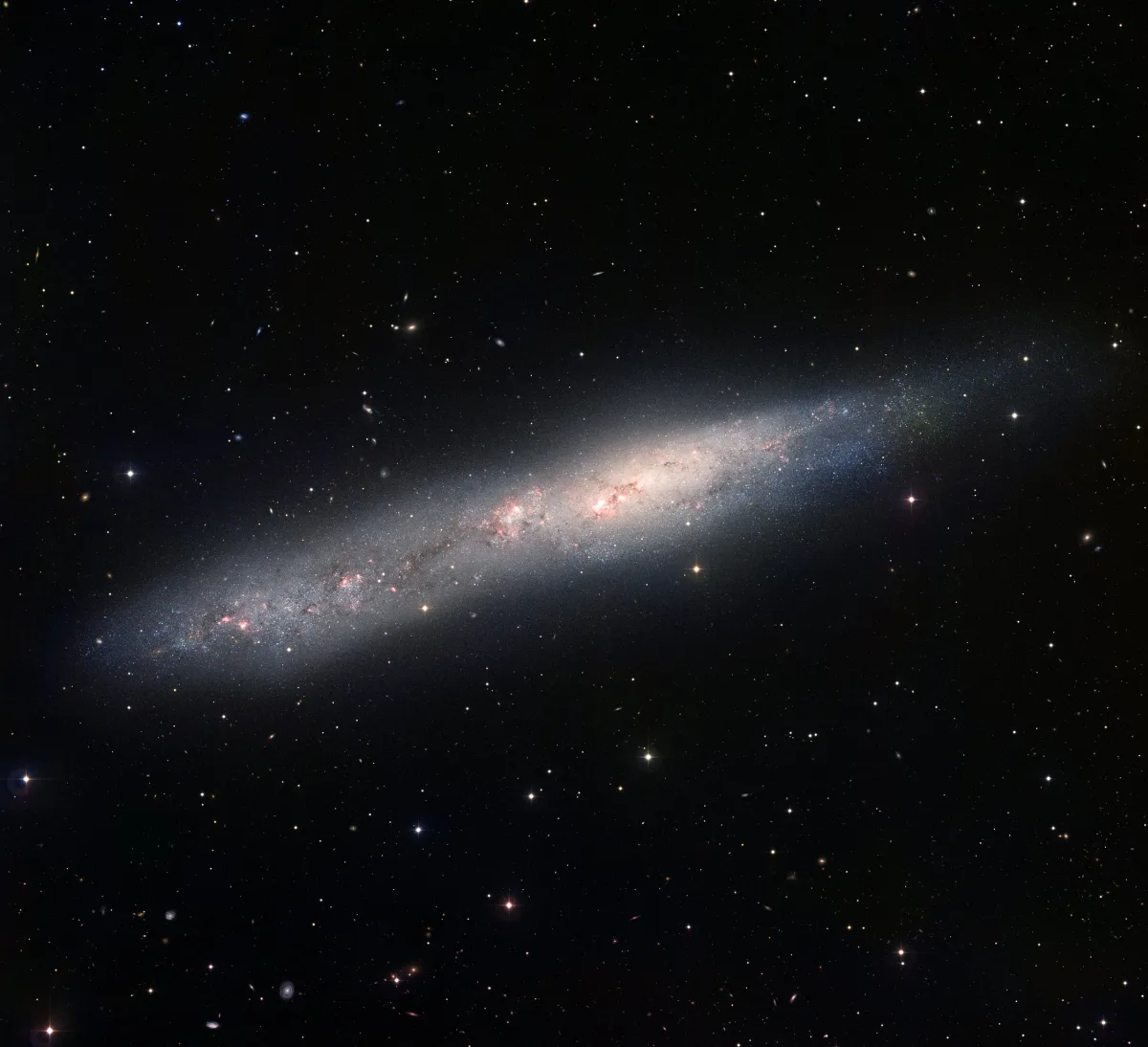
Image of the irregular galaxy NGC 55 obtained with the Wide Field Imager on the 2.2-metre MPG/ESO telescope at ESO La Silla Observatory. The image is based on data obtained through B, V, and H-alpha filters. North is up, East to the left. The field of view is 30 arcminutes wide. Image credit: ESO (CC BY 4.0)
NGC 55 is larger than the Large Magellanic Cloud, which spans 32,200 light-years across. The two galaxies appear similar, but NGC 55 appears edge-on. It appears smaller than the LMC in the sky because it is much more distant. The Milky Way’s satellite is 10 degrees across and lies only 163,000 light-years away.
NGC 55 lies 6.5 million light-years away and is one of the nearest galaxies to the Local Group, which hosts the Andromeda Galaxy (Messier 31), the Triangulum Galaxy (Messier 33), and our own Milky Way. In comparison, the Andromeda Galaxy lies 2.5 million light-years away and the Triangulum Galaxy is 3.2 million light-years away.
The String of Pearls Galaxy and its neighbour NGC 300 (the Sculptor Pinwheel Galaxy, C70) are believed to lie between the Milky Way and the Sculptor Group of galaxies. The two galaxies were once believed to be members of the Sculptor Group but are now known to lie in the foreground. The Sculptor Group includes the well-known Sculptor Galaxy (NGC 253, C65), the Claw Galaxy (NGC 247, C62), and the flocculent spiral galaxy NGC 7793.
NGC 55 and NGC 300 form a gravitationally bound pair. They are separated by only about 1 million light years. NGC 300 lies at a similar distance, 6.07 million light-years away, and is around 55,000 light years in size. With an apparent visual magnitude of 9.0 and an apparent size of 21.9 by 15.5 arcminutes, it can be observed in small and medium telescopes. It looks similar to the brighter and larger Triangulum Galaxy in the northern constellation Triangulum.
The String of Pearls Galaxy contains a large star forming region that has its own designation in the Index Catalogue, IC 1537. IC 1537 (LEDA 1050, ESO 294-1) has an angular size of 1.32 by 0.59 arcminutes. It appears in the centre of NGC 55. The H II region was discovered by the American astronomer Lewis Swift using a 16-inch refractor on September 23, 1897.
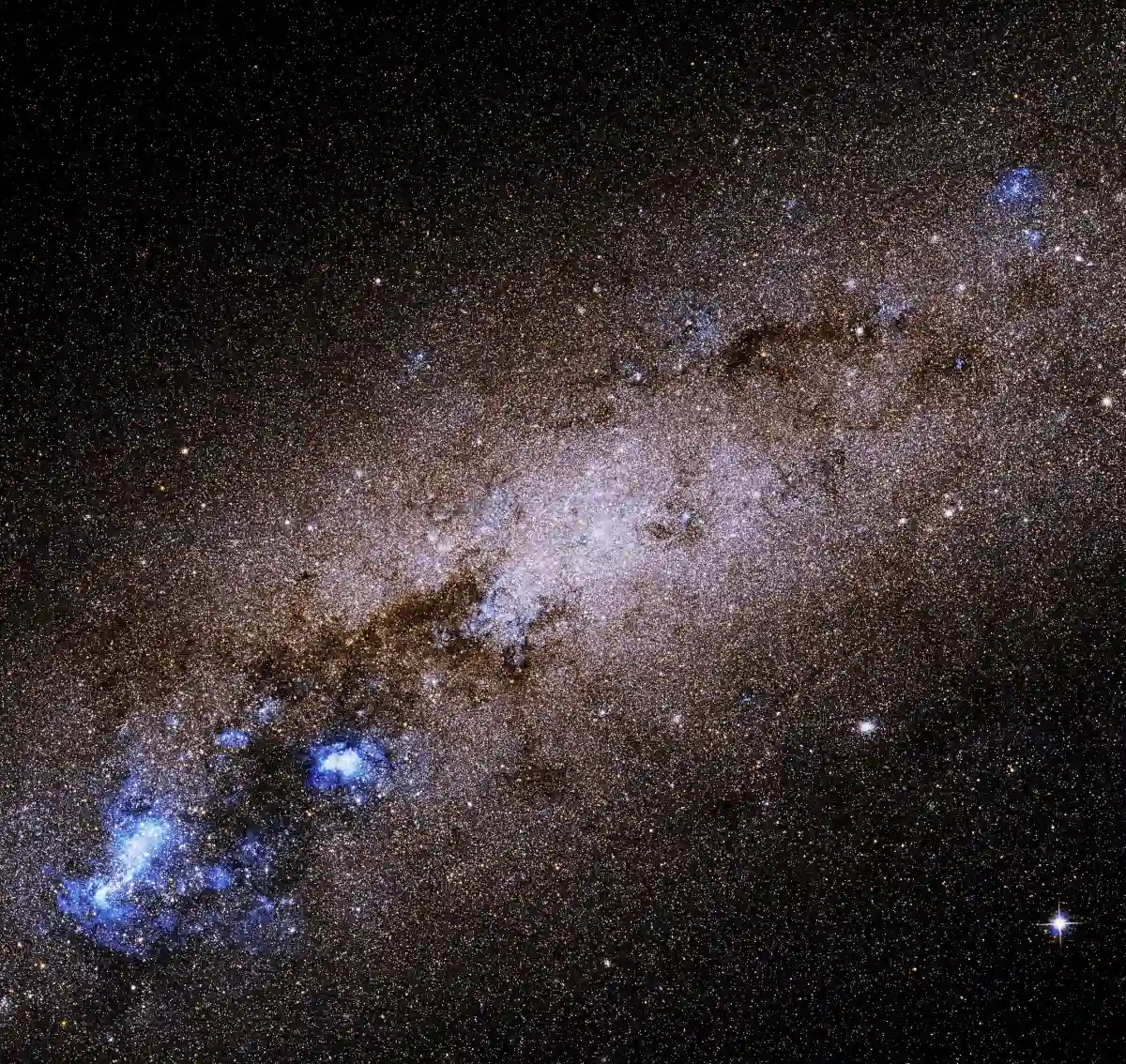
This image, showing a central part of Caldwell 72, is a composite of visible and infrared observations made by Hubble’s Advanced Camera for Surveys. The observations were taken to help astronomers understand how the distribution of the galaxy’s relatively small structures, such as dust clouds, affect how the light from the galaxy is dimmed as it passes through this intervening matter. Because light from the galaxy is partially obscured by the dust along our line of sight, it is important that we understand its small-scale distribution. Credit: NASA, ESA, R. de Jong (Leibniz-Institut fur Astrophysik Potsdam [AIP]), and G. Illingworth (University of California – Santa Cruz); Processing: Gladys Kober (NASA/Catholic University of America) (CC BY 2.0)
Facts
The String of Pearls Galaxy was discovered by the Scottish astronomer James Dunlop using his 9-inch reflecting telescope from Paramatta (now Parramatta) near Sydney, Australia, on July 7, 1826. Dunlop listed the galaxy as the 507th object in his “A catalogue of nebulæ and clusters of stars in the southern hemisphere,” published in 1828.
The astronomer noted, “A beautiful long nebula, about 25′ in length; position north preceding, and south following, a little brighter towards the middle, but extremely faint and diluted to the extremities. I see several minute points or stars in it, as it were through the nebula: the nebulous matter of the south extremity is extremely rare, and of a delicate bluish hue. This is a beautiful object.”
Dunlop discovered the nearby Sculptor Pinwheel Galaxy (NGC 300) about a month later, on August 5, 1826.
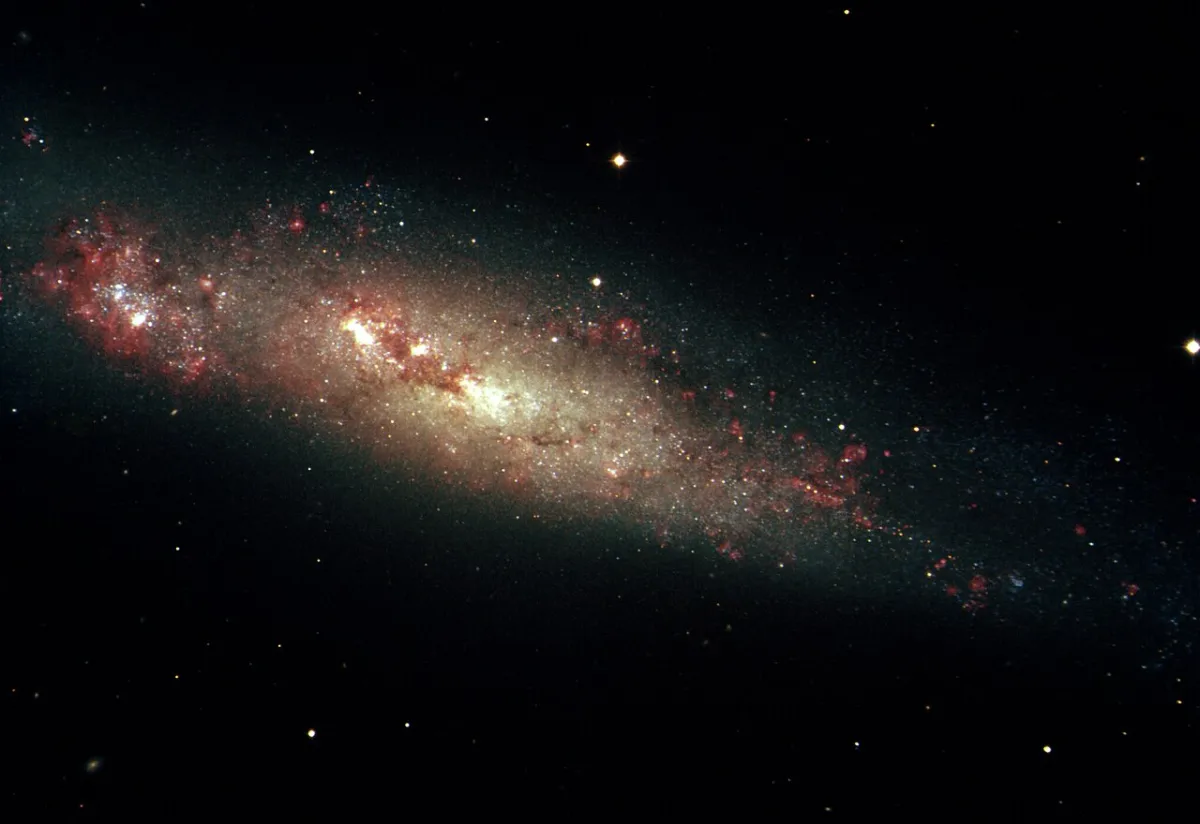
This image of the nearby galaxy NGC55 was taken with the National Science Foundation’s 0.9-meter telescope at Cerro Tololo Interamerican Observatory in Chile. NGC55 is at a distance of about five million light-years and resides in a gathering of galaxies known as the Sculptor Group. The red nebulosities are regions of active star formation in the galaxy. Image credit: T.A.Rector/NOIRLab/NSF/AURA (CC BY 4.0)
English astronomer John Herschel observed NGC 55 from the Cape of Good Hope in South Africa on September 4, 1834, October 23, 1835, and October 4, 1836. He listed it as h 2315 in his catalogue and described it as “very bright, very large; a very long irregular crooked ray with 3 nuclei, the second of which appears to consist of stars.”
NGC 55 is not to be mistaken for the other Whale Galaxy, NGC 4631 (Caldwell 32) in the northern constellation Canes Venatici (the Hunting Dogs). The two galaxies appear similar, with bright starburst regions on one side and the overall profile of a whale. The barred spiral galaxy NGC 4631 lies 30 million light years away and appears slightly smaller and fainter than NGC 55. Both galaxies are listed in the Caldwell catalogue of objects that can be observed in amateur telescopes.
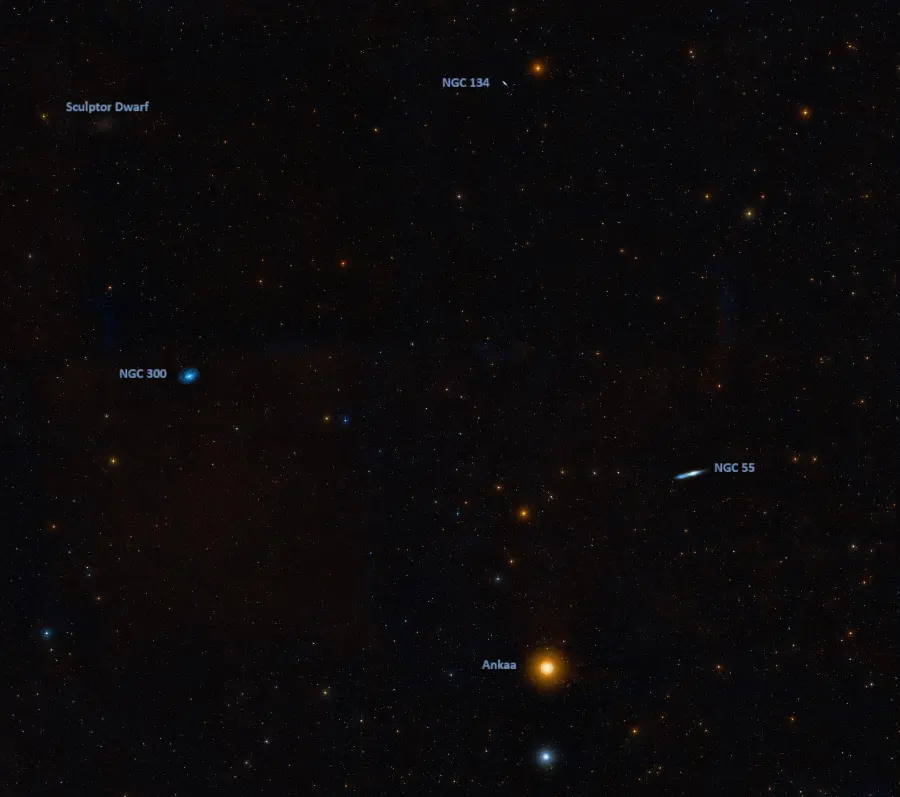
Ankaa, the String of Pearls Galaxy (NGC 55), the Sculptor Pinwheel (NGC 300), the Sculptor Dwarf and the Giant Squid Galaxy (NGC 134), image credit: ESO/Digitized Sky Survey 2 (CC BY 4.0)
Location
The String of Pearls Galaxy appears 3.6 degrees north-northwest of Ankaa (Alpha Phoenicis) in the sky, along the line extended from Ankaa in the direction of Delta Sculptoris. The Sculptor Pinwheel (NGC 300), the Sculptor Dwarf Galaxy (PGC 3589) and the more distant Giant Squid Galaxy (NGC 134) appear in the same region of the sky.
Ankaa, the brightest star in the constellation Phoenix, is the brightest point of light between Fomalhaut in Piscis Austrinus (the Southern Fish) and Achernar in Eridanus (the River).
With an apparent magnitude of 7.87, NGC 55 can be spotted in binoculars in good conditions. Medium telescopes will reveal the galaxy’s brighter western region.
At declination -39°, the galaxy is best seen from the southern hemisphere. It never rises for observers north of the latitude 51° N.
The best time of the year to observe NGC 55 and other deep sky objects in Sculptor is during the month of November, when the constellation appears higher above the horizon around 9 pm. The String of Pearls Galaxy appears the highest in the sky around midnight on September 28, when it is at opposition to the Sun.
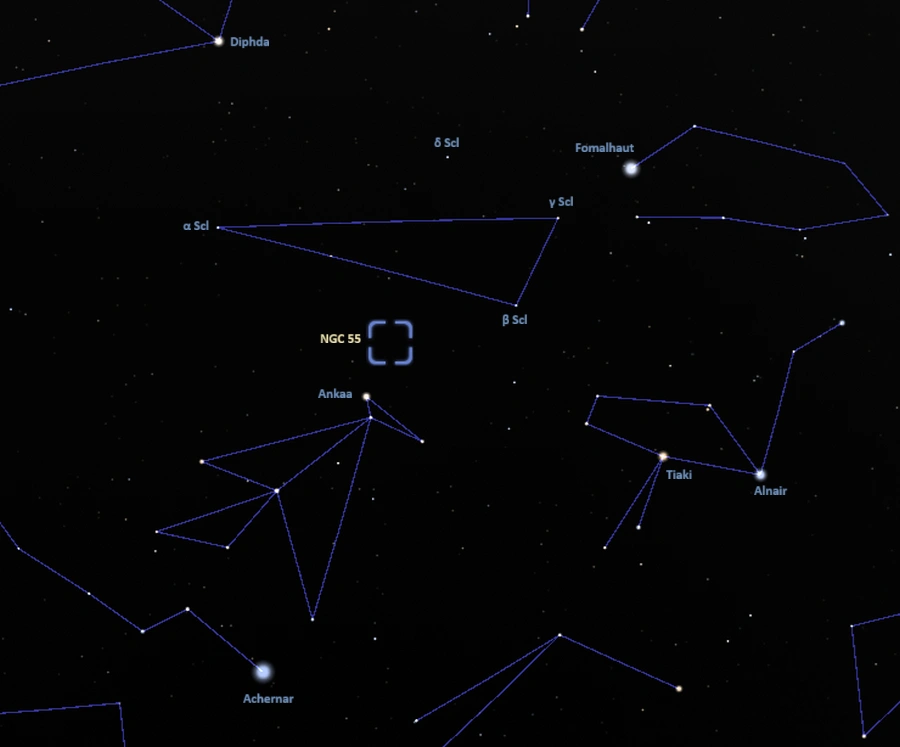
NGC 55 location, image: Stellarium
String of Pearls Galaxy – NGC 55
| Constellation | Sculptor |
| Object type | Barred spiral galaxy |
| Morphological type | SB(s)m or Irr |
| Right ascension | 00h 14m 53.602s |
| Declination | −39° 11′ 47.86″ |
| Apparent magnitude | 7.87 |
| Apparent size | 32.4′ × 5.6′ |
| Distance | 6.5 ± 0.65 million light-years (2.00 ± 0.2 megaparsecs) |
| Redshift | 0.000430 |
| Heliocentric radial velocity | 129 ± 2 km/s |
| Size | ~68,500 light-years (20.99 kiloparsecs) |
| Names and designations | String of Pearls Galaxy, Whale Galaxy, NGC 55, Caldwell 72, LEDA 1014, PGC 1014, ESO 293-50, ESO-LV 293-0500, MCG -07-01-013, IRAS F00124-3929, SB 968, SPB 2, IRAS F00124-3929, 2MASS J00145360-3911478, 2MASX J00145360-3911478, APMBGC 293-132-031, DUGRS 293-001, GLEAM J001456-391221, HIPASS J0015-39, LVHIS 004, NVSS J001458-391227, PKS J0015-3912, PMN J0014-3912,PSCz Q00125-3928, SGC 001238-3929.9, SUMSS J001458-391226, [VDD93] 1, [CAB95] IRAS F00124-3929, [CHM2007] LDC 26 J001453.60-3911478, [KS86] G0012-3930, [M98c] 001238.0-392954, [MI94] Sm 3 |